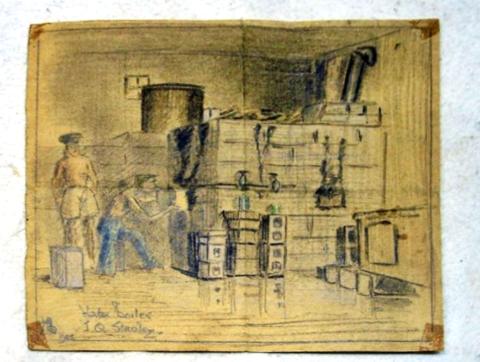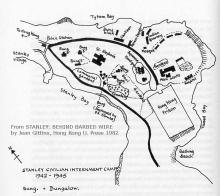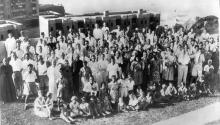These were originally 7 accommodation blocks, built to house Indian warders working at Stanley Prison.
During the Japanese occupation, they were part of the Stanley Internment Camp known as the "Indian Quarters", and housed 750 internees. The blocks were numbered 12 - 18.
As of 2014, the northern three blocks (numbered 12 / 13 / 14 in the 1940s) still remain, but the southern four blocks (numbered 15 / 16 / 17 / 18 in the 1940s) have been demolished and their site re-developed.
Notes on the Indian quarters extracted from 30 Nov 1943, Report on Stanley Camp from M S Gripsholm Repatriates:
LOCATION: In all, there are twenty-seven buildings comprising the camp. All have red tile roofs. [...] The Indian Officers' Quarters are constructed of red brick, and number seven in all.
DESCRIPTION: Group 3. Indian Quarters. All buildings in this group are identical. Each building has 6 flats, each flat of 2 rooms 10' X 12' and 8' X 12', occupied by 3 and 4 people respectively. Each double flat had 1 W.C. (native) and 1 small kitchen with a cold water tap. Placing person in one of these rooms meant overcrowding since there was no baggage space.
SANITATION:
-
Water supply. Boiled drinking water [...]; in the Indian Quarters blocks there were 2 electric boilers and a grass boiler for 750 people.
A sketch of a water boiler in the Indian Quarters:
Stanley Camp Sketch, by David - Washing and bathing. In Indian quarters there were no bathing facilities. There were no showers but each double flat improvised its own system of shower from its tap.
- Toilets. The water closet accommodation for the entire camp averaged 1 w.c. per 12 persons. The population of the whole camp was in August 1943, 2572 persons. In the Indian quarters, housing 750 persons, there was 1 native type W.C. for every 22 persons, while in the "Married" quarters, one for every 6 persons;
FOOD AND CLOTHING: Facilities for and method of preparing food. In the Indian Prison Guard quarters, no kitchen functioned and in this section of the camp the Japanese housed 750 Britishers, men, women and children. For a few days, these people were temporarily fed from another section of the camp. A kitchen was erected by the internees in the open garage for which all material had to be collected from around the hillside. Cement blocks from air-raid shelters, bricks from damaged buildings and red earth from the hillsides (used as cement) were collected by the internees and used by them in constructing the kitchen. The Japanese supplied nothing. Improvised tools were made and salvaged in the camp. [...] After the last of the Indian guards had vacated the camp, the Indian quarters kitchen was moved from the open garage to the vacated building. Again materials were gathered together by the internees. Cement promised by the Japanese was never supplied.



